The emergence of many forms of virtual worlds will be a notable trend in 2008. But Second Life as the largest and most highly developed user generated, 3D immersive world will continue to blaze the trail for the most world changing potential for virtual worlds – collapsing geography.
How virtual worlds will change understandings of national power is detailed masterfully by Cory Ondrejka in his article, “Collapsing Geography: Second life, Innovation and the Future of National Power.†Cory writes:
Networked innovation and collaboration means quantity may have a quality of its own. As education systems around the world approach parity, nations will finally be able to maximize the skills and potentials of their populations… No nation state will be able to compete counting only the people within her borders. The most successful 21st century nations will be those that redefine what it means to be a citizen and build the largest network of innovators.
Cory’s new blog is also called Collapsing Geography. But to truly fulfill the dream of collapsing geography the challenges to the scaling and interoperability of virtual worlds must be met.
Scaling the Second Life grid is vital if it is to fulfill the expansive vision of its founders. But scaling must progress along with goals of interoperability. No-one has the hubris to suggest that one homogenous grid should service the globe! As Cory Ondejka has left Linden Lab the scaling of Second Life is no longer his concern. But it is interesting to note that Cory has already indicated that it is likely he will be working on the other critical aspect of Virtual Worlds ability to collapse geography – interoperability.
Interoperability may come up as part of general discussions in APOC [Anneberg Program on Online Communities]. I think it is quite likely that I will be working on projects related to interoperability separate from my time at USC.
Scaling, adding new features, ensuring grid stability and developing interoperability will often seem to be competing values that Linden Lab has to juggle in 2008. Whereas Second Life pundits and residents often demand stability at all costs. It is not going to be that simple. The only truly stable worlds in the fast emerging virtual landscape of 2008 will be a small, closed, dead worlds, or perhaps, 2D worlds.
I came to the conclusion that 2008 really could be the year of interoperability, or at the very least the beginning of interoperability starting with increasing levels of web services for the SL grid, after talking to many of the movers and shakers on Second Life including Zha Ewry, IBM representative to the Architectural Working Group, John Jainschigg Exec. Director of CMP Metaverse, Cube Inada creator of Starbase C3, Aleister Kronos, Illuminous Beltran IBM, Gwyneth Llewelyn and others. I also attended many of the Architectural Working Group meetings.
I spent some time reading some of the excellent predictive posts for 2008 from meta thinkers such as, Cory Ondrejka himself (also see Cory’s review of his 2007 predictions in Terra Nova, Hamlet Au of New World Notes, and the Virtual Worlds Management team that has put together a 36 page Industry Forecast for 2008 (see Virtual World News for more on this and how to order a free copy), also some interesting predictions on Second Thoughts, Virtually Blind, Caleb Booker, Not Possible IRL, and Second Tense (the last is a somewhat tongue in cheek look at what 2008 may have in store for us). But only Hamlet of New World Notes makes a specific prediction re interoperability suggesting that a Second Life port to Sony Xbox 360 will be created.
Some Second Life commentators are making the prediction Linden Lab will not open source the server side architecture of Second Life in 2008. And while they may be right on this one, 2008 maybe more of a preparatory year devoted to cleaning up code and protocols, this probably won’t be an obstacle to achieving at least some of the goals of interoperability.
The fast development of OpenSim makes the open sourcing of Second Life server code something of a moot point. See my interview with Adam Frisby of OpenSim for a look at recent progress and some of the strengths of OpenSim architecture. The picture of OpenSim below is from NixNerd (see OpenSim Wiki). It is taken using Windlight.
Interoperability between OpenSim and Second Life in 2008?
Full interoperability between Second Life and OpenSim in 2008 is unlikely. I would put my money on 2009 for this. But a leading member of the Architecture Working Group suggested the following:
Three Achievable Goals for 2008.
Demos for:
1) Cross login for authentification – meaning that Tara5 Oh and her password would be the same in Second Life and an OpenSim that shared authentication with Linden Labs’s authentication servers.
2) Fetching assets between domains. This would mean being able to fetch assets from one space to another. For example I would be able to take my AV and my clothes from Second Life to OpenSim and back. Right now LL will only do this if they have a legal agreement with you not to steal stuff. The problem with off grid back up is that it is instant copy bot so one of the non-technical challenges is setting up the rules for connecting grids. (This also probably needs extended permissions so people can flag if they wish assets allowed off the SL grid.)
3) A tp (teleport) between an OpenSim and a Second Life sim. 1) and 2) are needed to do 3).
Integrating SL with The Web: SL and RESTful principles
I frequently attend the Architectural Working Group meetings on Second Life where Linden Lab, IBM, OpenSim and others meet to discuss open sourcing Second Life, open standards and interoperability. I am a silent observer as such gearhead matters as RESTful principles are usually what’s on the agenda.
Zero Linden’s office hours and Architecture Working Groupies’ meetings are where the warriors/artists of interoperability are to found. And the Linden Lab protocols are the clay from which standards are being molded. If you are serious about interoperability rolling up your sleeves and working with other teams whose objectives may not be exactly the same as you own is the challenge. As one AWG member put it:
Interoperability will emerge battered byte by battered byte from the hands of grubbie techies each with an agenda. Except on Second Life some of us are blonde, with a pert smile but yeah….
The Architecture Working Group is the first virtual world coalition that I know of to dig in and begin some heavy lifting re interoperability. AWG Meeting 2 is tentatively scheduled for 2008 Jan 31. The first AWG outlined some basic concepts for a new Second Life grid architecture.
One area of interoperability that will probably make big advances in 2008 is the better integration of SL architecture with WWW architecture which explains the talk of RESTful principles at AWG meetings! But as I have learned, the core activity of Second Life state merging delivered by the web is odd in relation to current web concepts. For the most part, the web for the last 30 years has largely been about delivering static content i.e. most of what people see stays the same for minutes, hours even days on end. The essence of what Second Life is about is collaboration around dynamic content. A good chunk of REST is about exporting state on a per state basis some of which you can’t do on SL as it doesn’t fit the model. As an AWG architect put it:
What SL does for a living is take inputs from 10 – 40 AVs and 40 times a second spit out a new state.
So Second Life is a very different animal from WWW. It doesn’t really match the core REST models. You can build on top of REST but the last bits are going to have to be different.
As far as I know no-one has really licked the user generated content plus 3D, plus REST equation yet. REST is.. 90% about saying: “Here is how the web works, and why as a consequence, it scales and models well.â€
Mashing the physical, the web and the online virtual
A different aspect of interoperability, mashing the physical, the web and the online virtual, is beginning to produce some interesting directions. And, what serendipity! The first link to my blog in 2008 came from Marta Lyall one of the prime movers behind a way cool project wrlds.com that is printing physical art objects representing big stock market moves, and creating a social network around this. The picture above is from the Wrlds web site.
Within the WRLDs System, participants can generate both virtual 3D and physical objects from their trading data. Translating trading data into these new forms creates a shareable social object from the symbolic language of trading
Artificial Intelligence Applications in 3D Virtual Worlds
While the development of distributed artificial intelligence in virtual worlds is certainly going to spawn a variety of killer apps one day soon, it is still early days for this. At the Virtual Worlds Conference and Expo, 2007 in San Jose, Ben Goertzel’s startup company Novamente LLC announced their collaboration with Electric Sheep Company to bring artificial intelligence agents (virtual pets) to online virtual worlds (see BBC News Coverage). Harnessing the wisdom of crowds in the rapid prototyping environment of a user generated, 3D world like Second Life presents an extraordinary opportunity for the development of Artificial Intelligence applications (see my post here on Artificial General Intelligence in Second Life).
The development of OpenSim and creating interoperability between OpenSim and Second Life in 2008 will create many new opportunities to create artificial intelligence applications in virtual worlds that require a secure and public platform. Already use cases and prototypes for energy management, predictive maintenance, building automation and network operation centers that are being designed to be integrated with AI are being developed on OpenSim (see my post on Eolus One’s work on building automation and Illuminous Beltran’s Virtual Network Operations Center).
In the picture above Illuminous Beltran (Michael Osias, IBM) is discussing with Zarathustrapoalypse (Ben Goertzel of Novamente) the possibility of having a virtual Artificial Intelligence system administration operation center that could diagnose problems and be able to describe them in an abstracted, qualitative format and then having conversational AI avatars to describe the problems to sys-administrators (and indicate them gesturally in the 3D sim world).
As Ben Goertzel of Novamente also has considerable experience applying AI to financial trading and understands both the data and the psychology of traders pretty well I asked what he thought of the Wrlds project, and how it could be developed with AI. Ben came up with a very interesting, off the cuff, AI tie in.
There is an AI tie-in, since AI can be used to analyze and extrapolate data, and their stuff could then be used to visualize the results…
But that would be a different sort of product, I would say… and a great one … imagine a data-analysis toolkit whose interface was part of a virtual world…
You view your data in the virtual world, a la the wrlds.com methods
You choose methods to analyze your data, via a metaphor of choosing physical tools in the virtual world…
You apply the tools to the data and visualize the results
I note the “toolkit†metaphor is constantly used in the data-analysis world…
Finance would indeed be the first market to look at here, since there is a big and mature market existing for financial data analysis tools…
Melanie Swan is also doing some interesting work on the visualization and analysis of financial data in virtual worlds (also see Melanie’s post on virtual world killer apps). She is developing a 3-d dynamic display of stock market data in her virtual office in Second Life. Go here for the on-demand real-time 3d stock charts in Second Life.

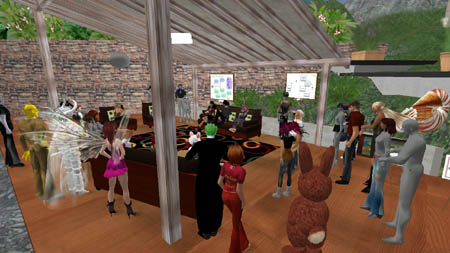
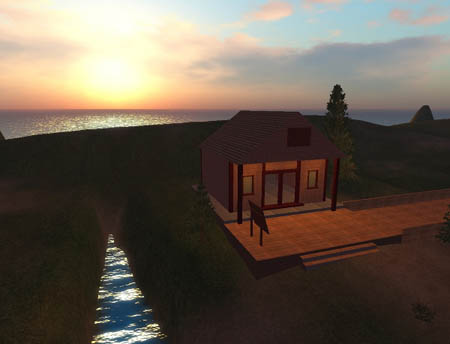
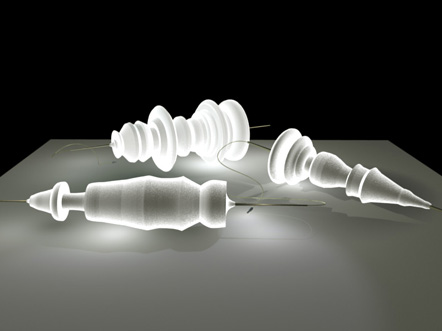
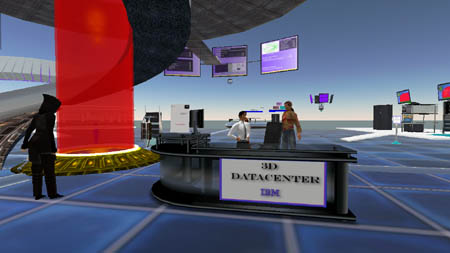
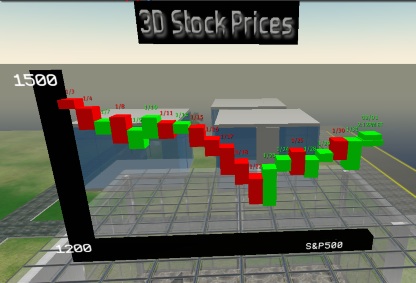
January 7th, 2008 at 12:05 pm
I applaud your courage in stating that “the only truly stable worlds in the fast emerging virtual landscape of 2008 will be a small, closed, dead worlds…” Though perhaps not a popular sentiment with the business communities of places like SL, the most compelling aspect of being (and staying) inworld for the rest of us is the progressive technological and social environments that can only be provoked by continually pushing the envelope.
January 7th, 2008 at 12:19 pm
Not to get too deep in the protocol guts, but RESTful web services are only half of what modern web servers have to offer. The web’s answer to the other half is Comet, which is a method of using HTTP to distribute server events like simulation updates.
Comet is currently in use by a lot of chat clients (e.g. Meebo) but is increasingly seeing support in other applications which require server generated events. For example, the Ogoglio platform uses RESTful web services as its stateless API and Comet for world events and user input.
January 7th, 2008 at 12:22 pm
For those interested in learning more about Comet: http://alex.dojotoolkit.org/?p=545
January 7th, 2008 at 8:32 pm
I heard that Comet has some interesting properties but was not a panacea.
January 7th, 2008 at 8:57 pm
To be more specific I heard there are several issues (with Comet). Push doesn’t always agree with firewalls. And you also have a new set of “did you see message X” issues. In some cases you get better fanout downstream but not always.
January 8th, 2008 at 11:11 am
Great article!
In this part of the world (Southern Europe), many clients are a bit scared of the bad press that poor SL has received in 2007 and continues to receive in 2008. I hope OpenSim and the trend toward the professionalization of SL will fix this. In the meantime I am seeing more positive responses to Open Croquet and Sun technologies.
Fabbing is absolutely fascinating and definitely a technology to watch, with a potential to make a big impact in a relatively short term.
More related thoughts here:
http://metaxlr8.net/index.php/site/interoperablity_now/
January 8th, 2008 at 1:05 pm
Really great post. Love your blog.
Cheers!
January 8th, 2008 at 1:17 pm
Check out the S&P 500 visualization display that EZ Martin built over Clear Ink Island.
described here: http://clearnightsky.com/node/278
visit here: http://slurl.com/secondlife/Clear%20Ink%20Island/162/32/105
January 8th, 2008 at 2:11 pm
I don’t think the Linden Labs Architecture Working Group is really pushing interoperability. It is just making sure that Linden-specific technologies and protocols can be used in a non-monolithic world. Real interoperability means a multi-vendor, multi-source universe. You can read more about one approach for that at http://www.interopworld.com/members/node/22
Another site to watch regarding virtual world interoperability is http://vwinterop.wikidot.com/ which is a consortium (including Linden Labs, IBM, Forterra, ActiveWorlds and others) working to drive real interoperability standards.
January 8th, 2008 at 4:05 pm
Thanks jon for the link to the vwinterop wiki and the work on multivendor interop I didn’t include it in this post on interoperability in 2008 cos this work is, in my understanding, a 2 to 4 year play. Have to do a future post on it!
January 8th, 2008 at 6:54 pm
Donovan Lnden is actually Donovan Preston, who has done plenty of work with Comet, as his website blog suggests: http://ulaluma.com/pyx/archives/2007/09/rest_to_lsl_via_python_and_comet.html
January 9th, 2008 at 4:26 am
Ben and Tish–
Regarding financial analysis and what we are doing at WRLDs. I worked as a licensed broker in order to further my understanding of the markets, and am still active as an independent trader. (I worked as a broker after my faculty experience in interdisciplinary work involving art, technology and the sciences). One of my core interests in developing WRLDs, was to find a method to address the human experience of trading. The creation and dissolution of markets has such broad implications for all of us; we experience it in all aspects of our lives. In the practice of many of the sciences it seems as though interacting directly with physical materials brings researchers outside of their “looking apparatus”, (as discussed by Michel Serres). It brings in information which is unexpected, and difficult to control. In the practice of human trading, (not algorithmic), it is as though one forgets that there are at times millions of other individuals attached at the same moment, via this technological apparatus, to exchange information, (the buy and sell), in a trading transaction. My intention for this project with WRLDs, was to develop our virtual space, (The Foyer), so that one could build a virtual form with your own trading data, in real time, and use it to both gain some distance from the experience of the transaction, as well as share it with others, and transform it with others. To use the data to “build something” which could have some value, other than the “exchange value” of currency. I wondered if this occurred, if it might not be similar to what I observed in the sciences when researchers interacted with physical materials, or worked with those outside their fields, and bring new insights into trading. Our current tools for trading, all repeat the same approaches to the data, with slight refinements or variations. It seemed there had to be other methods, that used more of what Derrida might consider as an expanded form of writing as in a hieroglyph; where a single abstract symbol contains layers of meaning. This would be in contrast to a symbol such as the letter “a”, or a number, which by itself, has very little significance.
I hope this makes sense.
January 14th, 2008 at 5:27 am
Second Life looks like a Videogame on my 1990s ATARI